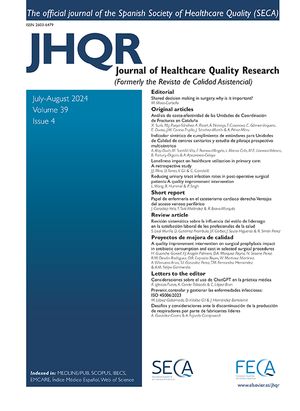La perspectiva del paciente es fundamental para evaluar el impacto de la asistencia sanitaria. Sin embargo, existen pocos estudios que valoren la perspectiva del paciente. Este trabajo se diseñó para evaluar los cambios en la calidad de vida relacionada con la salud (CVRS) en los pacientes sometidos a artroplastia total de rodilla mediante el cuestionario de salud SF-36.
Material y métodosEl estudio se aprobó por el comité de ética del hospital. Se diseñó un estudio prospectivo en 50 pacientes sometidos a artroplastia total de rodilla. Los pacientes completaron el cuestionario de salud SF-36 antes de la intervención quirúrgica y 3 meses después de la cirugía.
ResultadosLos pacientes tuvieron un incremento de 15 puntos sobre 100 en la escala función física del cuestionario de salud SF-36 (p = 0,003). Los pacientes experimentaron una disminución de 33 puntos sobre 100 en la escala rol emocional del cuestionario SF-36 (p = 0,02). Los pacientes que presentaron puntuaciones preoperatorias más elevadas en el componente mental del cuestionario de salud SF-36, a los 3 meses de la cirugía tuvieron mayores puntuaciones en el componente mental (p = 0,013) y en el componente físico (p = 0,02).
ConclusionesLa CVRS valorada mediante el cuestionario de salud SF-36 experimenta una mejoría en el componente que valora la función física, pero presenta un empeoramiento en el componente que valora la función emocional. El componente físico y el componente mental mejoran en los pacientes que previamente se encontraban con puntuaciones más elevadas en el componente mental del cuestionario de salud SF-36.
The patient perspective is essential to evaluate the impact of health care interventions. However, studies that evaluate the patient perspective are scarce. This study was designed to evaluate changes in health-related quality of life (HRQL) after total knee arthroplasty (TKA) through the SF-36 health-survey.
Material and methodsWe performed a prospective cohort study of 50 patients who received TKA. The study was approved by the hospital’s Ethical Committee. HRQL was evaluated with the SF-36 health questionnaire before knee surgery and 3 months later.
ResultsThree months after surgery, the patients showed an increase of 15 points out of 100 (p = 0.003) on the physical function scale score and a decrease of 33 points (p = 0.02) on the role-emotional scale score of the SF-36 health questionnaire. The patients with the highest scores in the mental component summary of the questionnaire before surgery also showed the highest scores in both the mental component summary (p = 0.013) and the physical component summary (p = 0.02) at 3 months of follow-up.
ConclusionsThe HRQL of the patients, evaluated through the health- questionnaire SF-36, showed an improvement in the physical function scale, but showed worsening in the role-emotional scale. The physical function summary and mental component summary of the SF-36 improved in patients who previously had the highest scores in the mental component summary.






